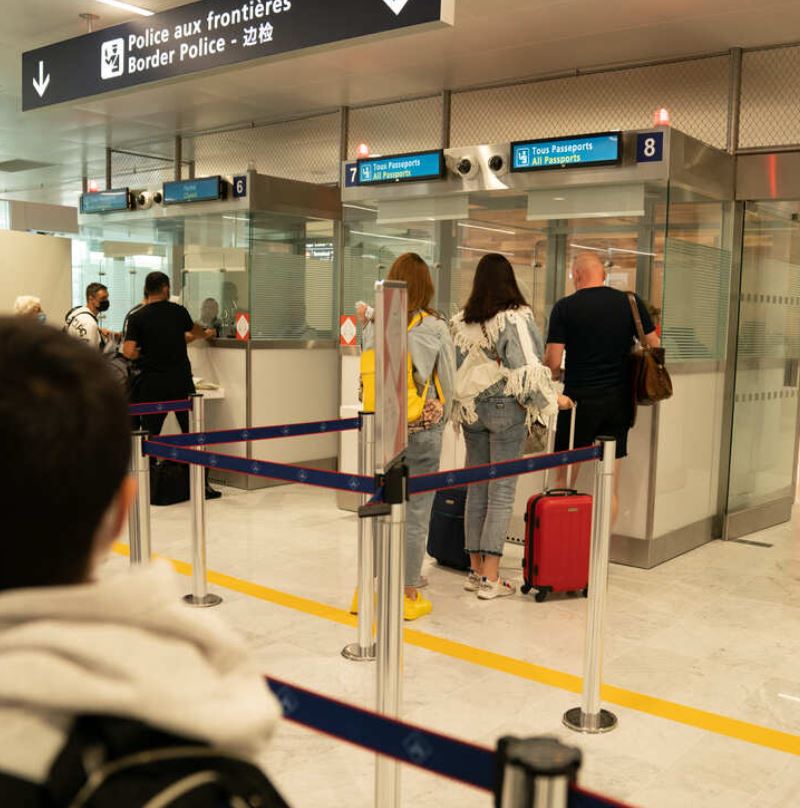It’s true Americans enjoy unrestricted access to most of the world, especially now that Covid curbs are being lifted, but international travel is never entirely hassle-free. In fact, 38 countries continue to require U.S. nationals to pay in order to enter, whether it’s a Visa On Arrival fee, an e-Visa fee, or when issuing an Online Travel Authorization.
The American passport is one of the most powerful in the world, being named the seventh best to hold in 2023, but this does not mean you are eligible to travel abroad by carrying a valid passport only. Numerous other non-health-related rules must be observed, from showing proof of a return ticket to qualifying as a visitor under certain visa restrictions.
In this article, you will know precisely which countries – and territories – have entry fees in place:
What Are The Differences Between VOAs, e-Visas, And ETAs?

First off, we must establish the key differences between Visas On Arrival (VOAs), e-Visas, and Electronic Authorizations:
VOAs
VOAs are required by countries the United States has not signed a visa-waver agreement with but whose immigration laws are still relaxed enough for Americans to travel without applying for a visa at a country’s mission or Consulate in advance. Instead, they can be applied for and issued directly at the border.
e-Visas
Electronic Visas, or e-Visas, on the other hand, are issued online and do not need to be affixed to your passport. It is one of the easiest to obtain, being automatically issued via e-mail upon completion of an online form. Travelers are then advised to have it printed or in PDF form and present it both at the check-in desk and later during border crossing.

ETAs
Finally, Travel Authorization (or Travel Authority in some regions) applies to U.S. citizens in cases where a visa-free travel accord is in force between the United States and a third state, but pre-registration is still mandatory. They are not considered a visa, though the application process often resembles that of an e-Visa, except it’s usually simpler.
One thing all three have in common? They are (usually) not issued for free and can cost anywhere between USD $7 to $250. Below, you will find the complete list of countries where VOA, e-Visa, and Travel Authorization rules apply, as well as their price*:
**Some prices are expressed in euros (€). Visa rules and fees are extracted both from official Government websites and iVisa, except where noted.

Africa
Africa is the strictest continent of all when it comes to visa rules. In total, only 14 countries offer complete visa-free entry to American tourists, and a further 23 nations either allow applications at the border or enforce an e-Visa regime. Luckily, these are quite easy to obtain, provided you fit the criteria.
In Cape Verde, for instance, travelers are expected to register in advance on the E.A.S.E. platform, as well as pay a processing fee and airport tax (fixed at €59 per applicant as of January 2023). In Egypt, visas can be issued online or at certain points of entry for only $25; additionally, the Seychellois entry permit is free but must be requested once landing in the Seychelles:

VOA – $190 for single-entry (1 month), $245 for multiple entries (3 months)
VOA – $70 for single entry, $90 for multiple entries within a 30-day period
e-Visa – $63.66 for a 90-day permit
VOA – €30 for a 45-day permit
e-Visa, VOA – $25 for a 30-day permit
e-Visa – $52 for 30 days, $72 for 90 days

e-Visa – €85 for single entry (one month), €200 for multiple entries (six months)
e-Visa – $67.6 for a 90-day permit
e-Visa, VOA – $30.58 for single-entry (30 days), $38.23 for multiple entries (60 days), $53.52 for multiple entries (90 days)
*Source: VisaHQ
e-Visa, VOA – $75 for single-entry (3 months), $150 for multiple entries (6 months), $250 for multiple entries (12 months)
VOA – €55 for a 30-day permit
*Source: Nouakchott Airport

e-Visa, VOA – $50 for single entry, $70 for multiple entries within a 30-day period
VOA – $160 for a 3-year multiple-entry visa
VOA – Approximately $50 for a 30-day permit*
*Travelers are advised to contact a Somalian mission in their home country to obtain more information.
VOA – $126.99 for a 30-day permit
VOA – $50 for a single entry, $100 for multiple entries within a 3-month period

VOA – $190 for a 30-day permit
VOA – $40 for a 90-day permit
VOA – $50 for a 90-day permit
e-Visa, VOA – $50 for a 90-day permit
e-Visa, VOA – $30 for single entry, $45 for double entries within a 3-month period

Asia
In Asia, fewer countries maintain border formalities affecting U.S. travelers compared to Africa. Still, the list comprises ten destinations, some of which are incredibly popular among backpackers vacationing in the area – especially when they are young and broke and looking to save money as much as possible when traveling.
After all, dollars stretch the furthest here, helped by weaker currencies and the low cost of living. Despite their huge affordability, Asian countries are infamously known for their hefty entry fees, which may come in the form of visa restrictions or pre-travel registration requirements. Ahead of visiting these spots, Americans must arrange more than a simple passport:

VOA – $50 for a 30-day entry permit (a departure tax of $6 also applies)
e-Visa, VOA – $36 for a 30-day entry permit
e-Visa, VOA – $36.62 for a 30-day entry permit

VOA – $25 for 15 days, $40 for 30 days, $100 for 90 days
Source: Nepal Airlines
ETA – Approximately $10, valid for individual visits of up to 90 days within a two-year period
ETA – $30, issued for up to 30 days
VOA – $30, issued for up to 30 days and renewable for a further 30 once inside the country – available to air arrivals only

Americas & Europe
No countries or territories in the Americas – North, Central, or South – or Europe with whom the U.S. has signed visa-waver agreements with currently require Americans to obtain ETAs and thus pay an entry fee upon landing. In the Americas, the only countries that have imposed visa restrictions on U.S. citizens are Cuba, Venezuela, and Bolivia.
In Europe, a new Entry-Exit System is set to come into force in late 2023, accompanied by their new ETIAS, or Travel Authorization program. Once it’s fully functional, American tourists will be expected to apply for an ETIAS and pay a fee in order to be eligible to enter Europe’s Schengen Zone – much like the Australian, New Zealand, and South Korean models.

Outside Schengen, Americans cannot travel to Belarus and Russia without having obtained a permit. Thus, the only open Eurasian country demanding an entry fee for U.S. passport holders is Turkiye – formerly known as Turkey:
e-Visa – $50, single or multi-entry during a 3-month period, within 180 days

Middle East (Western Asia)
Despite the draconian laws some Governments in the Middle East have enacted over the last few years affecting their own nationals, the region is relatively open for foreigners, allowing them to visit without observing strict dress codes – bar when religion’s concerned – and opening numerous leisure complexes where Western customs are welcomed.
Despite the increasingly liberal policies, some countries have yet to relax their visa requirements or lift entry fees. In Jordan, for instance, a ‘Jordan Pass’ must be issued prior to departure, and while the list of inclusions is extensive, with not only entry fees added to the package but also a number of tourist attractions, the mounting costs can be a deterrent*.

*Especially when flying to these countries from the U.S. is already quite expensive.
e-Visa, VOA – $19, issued for up to 14 days
VOA – $60, issued for up to 30 days
*Visitors can alternatively apply for a Jordan Pass, including entry to over 40 attractions inside the country + the visa fee. Prices range between $98.69 and $112.79.

e-Visa, VOA – $9, issued for up to 3 months
e-Visa, VOA – Multiple entry for $123, with a one-year validity. Visits cannot exceed 90 days at a time.
Oceania
Lastly, there are only 7 nations and territories in Oceania Americans are not permitted to cross the border for free. The most famous examples, Australia and New Zealand require the submission of an online form in advance, known as Travel Authority, which functions like an e-Visa, though issue is almost always automatic once the fee is paid.
In Australia’s case, an ETA is valid for only a year, and U.S. passport holders can freely cross the border for individual visits of up to 90 days at a time within this period, as long as they do not engage in paid activities during their stay. Conversely, the New Zealand ETA (shortened to NZeTA) can be delivered with a two-year duration.

ETA – AUS $10, valid for a year with short-term visits not exceeding 90 days
ETA – NZD $17 through the app, $23 through the official website.
*An additional Visitor Conservation and Tourism Levy (IVL) of $35 is charged.
e-Visa, VOA – $50 issued for up to 30 days

Check Your Visa Requirements Ahead Of Traveling
This is a round-up only, and we are not able to provide more detailed information about Visas On Arrival, e-Visas, Electronic Travel Authorization, and entry fees for specific countries. We suggest you contact the relevant authorities at your destination or a travel agency specializing in non-immigrant visas.

